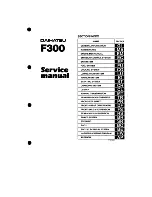
(2). VVT Control Strategy
Driving
Conditions
Intake Valve
Timing
Cause
Low-Load
Lag
Steady
Combustion
High Load, High
Speed
Lag
Increased Output
Characteristics
High Load, Low
Speed
Advance
Increased Torque
Medium-Speed
Condition
Advance
Improved
Fuel
Consumption
(3). Advance Process
3
4
2
1
5
FE02-2066b
Legend
1. Lag Chamber
2. Locking Pin
3. Advance Chamber
4. Rotor Blade
5. Bracket
In normal operation condition, the oil pump generated engine
oil pressure applies on the VVT solenoid valves. ECM controls
the VVT solenoid valve by pulse-width modulation. When ECM
needs VVT to adjust the intake valve to the maximum advance
position, ECM controlled the VVT solenoid valve opening is
100%. At this point the engine oil pressure applies to the
advance chamber, VVT rotor blades move in the opposite
direction relative to the crank angle and eventually stay at the
maximum position.
idling without load VVT actuator position will generally remain
at the 8 ° or so, due to intake valve mechanical opening angle
is 5 °, so the intake valve opens at idle with actual angle of 13
°.
(4). Lag Process
1
FE02-2067b
Legend
1. Lag Chamber
In normal operation condition, the oil pump generated engine
oil pressure applies on the VVT solenoid valves. ECM controls
the VVT solenoid valve by pulse-width modulation. When ECM
needs VVT to adjust the intake valve to the maximum lag
position, ECM controlled the VVT solenoid valve opening is
0%. At this point the engine oil pressure applies to the lag
chamber, VVT rotor blades move in the same direction relative
to the crank angle and eventually stay at the maximum position.
2-308
Engine Mechanical System JL4G18-D
Engine
EC718/EC718RV EC715/EC715RV 10/2009
Summary of Contents for EC715 2009
Page 4: ......
Page 330: ...Next Step 10 End 2 248 Fuel System JL4G18 D Engine EC718 EC718RV EC715 EC715RV 10 2009 ...
Page 1164: ......
Page 2008: ......
















































